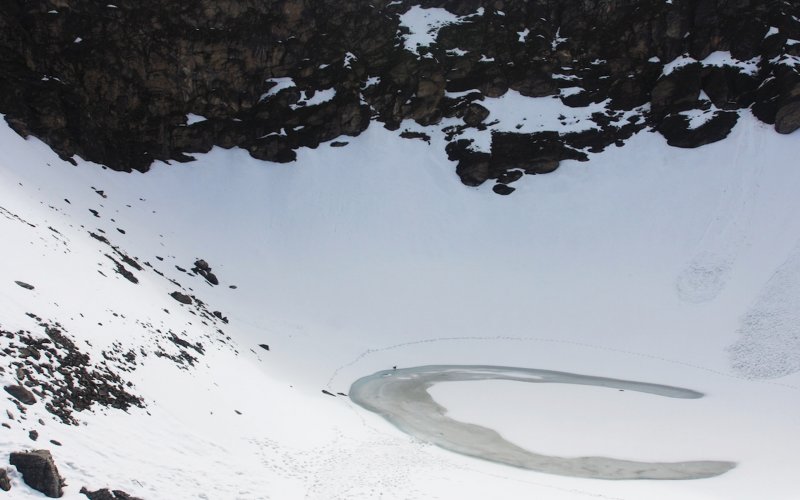
© Sanjeev Asher/Flickr
For decades, experts puzzled over hundreds of ancient dead bodies found at a remote lake. Were they victims of disease? Mass suicide? War? The answer is weirder than you think.
For one month a year, the icy waters of
Roopkund Lake melt enough to reveal scattered skeletal remains of 200 humans who perished in the region 1,200 years ago. Because of the harsh conditions of the remote lake, nestled 15,750 feet in the Himalayan mountains of India bordering Nepal and only accessible via a five-day ascending
trek, scientists estimate there could still be 400 undiscovered bodies.
This grisly find was first uncovered by a British forest ranger in 1942, and immediately inspired legends to explain the identities of the mysterious group of dead trekkers. It was first posited that they were Japanese soldiers who had died while crossing the area during World War II. But that was soon debunked by the age of the bones. Others believed them to be the remains of the Kashmir warrior Zogawar Singh and his army, who were lost returning from Tibet. And still others theorized the bodies were a result of a battle, epidemic, landslide, or a ritual suicide.
For decades, their cause of death remained unsolved. But a half century later,
DNA testing of the bones found none of the initial theories to be true, and discovered something even more unbelievable. Analysis showed that the bones belonged to two separate groups traveling together who were killed by giant blows to their heads and shoulders. Cause of death? Massive hail and nowhere to hide.It wasn't until 2004 that a proper investigation into the deaths began, and the mysterious remains were revealed to the world. National Geographic Channel commissioned European and Indian researchers to retrieve the bones and tissue samples from the area and analyze them.
A team of scientists concluded that the party, which was comprised of a related tribe of pilgrims and another group, probably porters hired to carry their luggage, died when a storm hailed down ice balls measuring nine inches in diameter. "The only plausible explanation for so many people sustaining such similar injuries at the same time is something that fell from the sky," one of the researchers
said.
Along with the skeletal remains, they also found a number of bodies beneath the ice that shockingly still had hair, skin, and nails, as well as clothing and jewelry, that were fully intact. The freezing cold water of the lake likely preserved them for the next thousand years.
These finds have supported the oldest legend surrounding the lake, passed down through the centuries by locals. According to that
lore, the skeletons are what's left of a pilgrimage trip taken by King Jasdhava, his princess wife, and entourage to honor the goddess Nanda Devi. They disobeyed the deity's wishes by dancing and playing music on sacred ground, and she unleashed a deadly hail storm down upon them. The pilgrimage to Roopkund Lake and the nearby worship site of Hemkund is still undertaken every 12 years by devotees in the region.
As wider attention has turned to this morbid find, the skeletons have begun disappearing, plucked out of the lake and carried away by curious visitors. According to
local officials, tourists have been hauling away so many skeletons each year that "only a few remain," and because the region is so remote - tucked away nearly 16,000 feet in the sky - it is difficult to protect.
Reader Comments
to our Newsletter